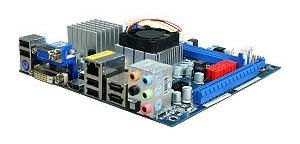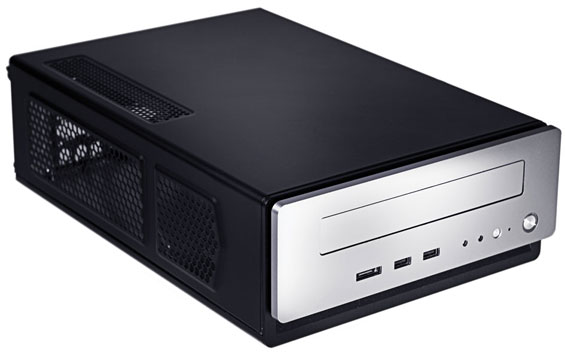Nettop and Mini-ITX Buyer’s Guide
by Zach Throckmorton on April 22, 2011 2:00 PM ESTIntel Upgraded HTPC Nettop
| Intel Upgraded HTPC Nettop | ||
| Component | Product Name | Price |
| CPU + Mobo | ASRock A330ION (Atom 330 + NVIDIA ION) | $120 |
| Memory | Patriot 4GB (2x2GB) PSD34G1333K | $40 |
| Case + PSU | Antec ISK310-150 Black/Silver + 150W PSU | $80 |
| Storage | Samsung SpinPoint MP4 HM640JJ 640GB 7200RPM 16MB | $60 |
| Optical Drive | Sony Optiarc BC-5500H-01 BR-ROM/DVD-ROM | $90 |
| Operating System | Windows 7 Home Premium 64-bit | $100 |
| Extra Software | CyberLink PowerDVD 11 Ultra | $100 |
| Total Price | $590 | |
For our upgraded configurations, we’re going to look into making something that’s a bit more capable as an HTPC. On the Atom side, the only way you can do that is if you get a better GPU than the 3150, and the easiest (and cheapest) way to do that is to purchase an ION motherboard. With the arrival of AMD’s Brazos, most motherboard manufacturers are shifting to that platform. It certainly doesn’t help that when Intel moved from the original Atom platform to Pine Trail, they integrated the Northbridge into the CPU package and  essentially killed off the ION chipset, so now you’d have to get a Pine Trail board with a PCIe slot if you wanted a discrete GPU. The result of all this is that we’re sticking with the older Atom 330 + ION for our upgraded Intel configuration, which is not without drawbacks.
essentially killed off the ION chipset, so now you’d have to get a Pine Trail board with a PCIe slot if you wanted a discrete GPU. The result of all this is that we’re sticking with the older Atom 330 + ION for our upgraded Intel configuration, which is not without drawbacks.
For this setup, we’ve selected the ASRock A330ION board, but availability and pricing can be a little sketchy on any of these older ION boards. As one of the major flaws with the Atom platform was its inability to play HD video smoothly, NVIDIA used their ION (a rebadged 9400M chipset) to address this issue. Paired with the dual-core Atom 330 CPU, this platform can play HD videos and even Blu-ray content—though not 3D Blu-ray. The ASRock board also has VGA, DVI, and HDMI ports. We first looked at the ION platform almost two years ago, and you can still get a good idea of its capabilities and limitations from our original assessment. For the memory, we’re again using desktop DIMMs, but now we’re upgrading to 4GB (2x2GB) of Patriot memory. The basic desktop DDR3 kits seem to have bottomed out at around $40 shipped without rebates. 2GB is sufficient, but the $18 extra can provide more headroom for multitasking.

The remaining components once again depend on the case selection, and we’ve selected the upgraded Antec ISK310-150 this time. We like this case a lot because it comes with a reasonably quiet 80mm fan, typical minimalist Antec aesthetics, and uses an external power adapter (which makes no noise, and is more efficient than internal power supplies—especially considering these low-powered nettops draw at most 25-30% of even a low wattage 150W PSU). It’s also available with a black bezel if you prefer that to the silver bezel. As with the ISK 100, this case uses 2.5” laptop hard drives, not 3.5” desktop hard drives. We’re only using one HDD again, but this case can fit two drives so SSD + storage drive is again an option.
For the hard drive, we’re going to offer an alternative to the 500GB Seagate that has seen so much use in laptops during the past year. Samsung recently launched their 640GB 7200RPM SpinPoint MP4 HM640JJ, at the same $60 price point as the Seagate. The higher areal density should improve sequential transfer speeds, and it will certainly be faster than the 5400RPM laptop drives. For the optical drive, you could stick with the same Samsung mentioned in the basic Intel configuration, but our upgraded nettops are going to take more of an HTPC role so we’re going the Blu-ray route. Slim BD-ROMs are difficult to find for less than $100, and in fact this is the only slim BD-ROM Newegg currently stocks. Note that it’s a DVD-ROM as well, so there are no burning capabilities to speak of—we suggest you use a different system for burning, and particularly video encoding/transcoding as such tasks can be painfully slow on Atom.
If you’re going to watch Blu-ray movies, you’ll also need appropriate software. The software included with the Sony drive is underwhelming, and CyberLink’s PowerDVD Ultra tends to work well with a variety of platforms. It also happens to cost $100, so you might want to start with the basic Blu-ray software and only upgrade if you want access to other features.
With all of the upgrades and a copy of PowerDVD, the total system cost is nearly double that of the base Atom setup, though much of that comes from choosing to include Blu-ray support. $590 is a lot to pay for an Atom nettop, certainly, and we’ll discuss other options in our conclusion. If you want to skip out on Blu-ray playback, you can get the above system for $400. Using the same case and components, the difference in motherboard choice makes this platform $10 more than the basic AMD E-350 setup, or $37 more than the stock Atom configuration.










101 Comments
View All Comments
StardogChampion - Tuesday, May 10, 2011 - link
A link would be helpful: http://outsidethestb.blogspot.com/2011/02/dc-psu-m...Leave a comment with contact info if interested or drop my the HTPC forum on AVSForum.com and find me. I build them to order.
It's a crazy hobby, isn't it?
FullHiSpeed - Friday, April 22, 2011 - link
"the case is 7.5” tall"http://www.thermaltakeusa.com/Product.aspx?C=1419&...
Dimension (H*W*D) ... 5.12 x 8.66 x 13 inch
JarredWalton - Saturday, April 23, 2011 - link
Fixed... Amazon appears to have the wrong dimensions (or they used the box dimensions). Anyway, 5.12" is still about 1" taller than the other cases.kenyee - Friday, April 22, 2011 - link
I'm looking for something that would work w/ MythTV w/o using a separate audio cable...Bummer that none of these can do 3D Bluray yet...that means you still have to have an external Bluray player :-P
hnzw rui - Saturday, April 23, 2011 - link
The Core i3-2100T does 3D. Just not sure about Linux support.shamans33 - Friday, April 22, 2011 - link
There's a lack of direct comparisons between different cases and PSUs.I build quite a few mini-itx systems and this "guide" doesn't cover AMD high end offerings, common pitfalls in building mini-itx systems, noise, actual temperatures, heatsink clearance, actual power usage, alternative PSU choices, many mini-itx case choices, etc.
Furthermore, accessories are not even discussed and there isn't an emphasis for including wireless capabilities in the system.
This guide reads like an advertisement and doesn't have the really essential information people need to decide what parts to get.
Gigantopithecus - Friday, April 22, 2011 - link
I'm sorry you feel that way, shamans33. The primary goal of the guide was to describe the components available for building a nettop, i.e. systems that take up little physical space and use low-power components.Having built many mini-ITX systems, I'm not exactly sure what you're referring to? The Atom and Zacate boards all include heatsinks that will fit in any of the mentioned cases, which should be obvious from pictures of the products. The extremely low-profile stock i3-2100T heatsink fits in the Thermaltake case recommended in that specific system. Temperatures have never been an issue for me in these cases and configurations, so I didn't think that warranted elaboration. As for alternative PSUs - again, these all come with integrated PSUs or external power bricks, and we recommended alternatives to the stock Thermaltake case's PSU. Others commented on inconsistent case choices - we presented five mini-ITX cases that we've used many times and have been more than satisfied with. This article was not supposed to be an exhaustive list of mini-ITX cases... As for actual power usage, narrow ranges are given, and we pointed to more in-depth articles on Anandtech that give exact figures.
As for accessories, including wireless, a nettop is just like any other desktop PC. You get the accessories to go with it that you want, and I didn't think those were within the scope of this article. Wireless is a good example - it's not like USB WiFi adapters are new and exciting technology...
I tried to describe what these systems can do, what they can't do, and pointed out where to go if you want to find out more about exact capabilities. I honestly have to wonder if you read the entire article. :P
shamans33 - Saturday, April 23, 2011 - link
I'll give you some examples...In-win BP and BQ series cases
880g and 890gx amd mini-itx motherboards
High end AMD CPUs
M350 case with PicoPSU
Low profile, high performance CPU heatsinks
Single slot low-profile pciex cards (because of space restrictions usually).
Mini-itx systems often have functional roles that are different from typical desktops and would have a different set of recommended accessories: wireless keyboards, esata/usb3 docks, etc.
Here's one system spec I recently built:
BP655 - $40
Zotac 880G - $115
2x2GB DDR3 - $40
AMD X3 450 - $80
500 GB HDD - $40
OS - $100
Total: $415
12.20" x 3.90" x 10.40" (Far smaller in every dimension than your final option)
200W PSU
1x 80mm fan.
Wireless-b/g/n
Gigabit ethernet
USB3
Sata3
You can even pair a 5.25" optical drive with a 2.5" SSD and a 3.5" 2 or 3 TB HDD.
You could call it a nettop buyers guide. But I wouldn't call it a mini-itx buyers guide.
shamans33 - Saturday, April 23, 2011 - link
Another build I've done in the past:M350
SILVERSTONE NT07-775 90mm CPU Cooler
Intel E5400
Zotac 9300G
PicoPSU-80
2x2GB DDR2
750GB HDD
DVD-RW slot drive
At-wall power usage: 27W Min. 35W Average. 45W Peak.
192 x 210 x 62mm , 2.5L
ET - Saturday, April 23, 2011 - link
I agree. I would have preferred an article about mini-ITX cases that doesn't have all the other fluff, and can provide comparison of heat performance and other details.